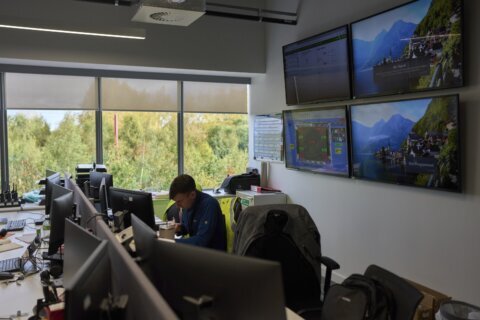Peek into an early-grade classroom at a Montessori school and you are likely to see children of different ages moving around and talking, free to explore a variety of activities. Each activity will advance learning and development, but may not include instructions on exactly what to do and when.
A Montessori school is an environment with plenty of materials for hands-on learning, and children are encouraged to focus on — and often stick with — activities that pique their interest. This stands in contrast to traditional school, where students in the same grade generally move through a structured and scheduled curriculum.
Montessori schools view children as explorers with different interests, recognizing that not all children learn the same way and at the same time.
“Parents can expect their children will receive a differentiated education geared toward creating the optimal outcomes for the child,” says Christiane Leitinger, director of enrollment management at the Montessori School of Evergreen in Colorado.
What Is Montessori Education?
Montessori education was created by Maria Montessori, the first female physician in Italy, whose work in a psychiatric clinic in the late 1800s drove her interest in child development. She continued studying education, philosophy and psychology and opened a preschool in Rome in 1907.
Montessori recognized the importance of giving children ownership of their learning. Her successful, child-centered teaching methods caught on and, for the next several decades, she wrote and established teacher training programs throughout Europe. Her influence quickly reached the U.S., where Montessori-inspired schools have blossomed for decades.
[READ: The Importance of Learning Through Play.]
More than 3,000 Montessori schools operate in the U.S., according to the National Center for Montessori in the Public Sector, and about 570 are public schools.
“She really understood the needs of children at a time when child development wasn’t necessarily part and parcel of schools in general,” says Jill Morgenstern, a teacher and writer in Texas who attended a Montessori school and chose the same for her child. “It’s amazing how far ahead of her time she was.”
Teachers as Guides
Respect for child development is one of the foundations of Montessori classrooms. Students with mastery of certain skills are free to go on ahead of typical grade-level expectations, while those who aren’t yet ready can take more time. Giving children that choice is an essential characteristic of Montessori education.
“One significant difference is that children have the opportunity to choose their own activities and lessons in a way that’s not possible in a traditional school environment,” Morgenstern says.
Teachers in Montessori schools often play the role of guides and observers. Depending on what they see, they might intervene to assist or step back and take note of a particular child’s ability to work through a problem. Proponents of Montessori education say allowing children to follow their curiosity and take control of their learning leads to more independence at an early age.
“Parents can also expect their children to develop a love of learning that is evident in their excitement to experiment, research and try to figure things out,” Leitinger says.
Leitinger cites an example of a student who completed all the scope and sequence work in kindergarten math. Rather than putting his learning on hold, the teacher retrieved first-grade math lessons from the elementary school and the student moved on.
In higher grades, this same concept can bring students outside the classroom to learn practical life skills. Leitinger says students in grades 6-8 at her school have internship opportunities in which they can identify a skill they want to learn and find a mentor to help them.
“Much of what they work on is not only the skill but also project management, so they can complete the task in the time required,” she says.
[READ: How to Choose After-School Activities.]
A Parent’s Perspective on Montessori
Simone Davies decided to send her kids to a Montessori school after attending an open house session for a Montessori preschool. She wasn’t interested in the traditional educational experience she had growing up. When she first visited a Montessori school, she was impressed with how independent and thoughtful the students seemed.
“It was so inviting — it had all of this really challenging material if the children wanted it, but also just a variety of different activities,” says Davies, who is now a Montessori teacher. “And the educators were so kind and respectful not only to us, but also the children in the way they spoke with them.”
Davies says it can be hard for parents to accept the lack of control they might feel when their kid goes to a Montessori school, especially in the early years. Since students learn at their own pace, it may be concerning to see your child make little progress in an area where you think they should be at grade level. But with time and patience, she says, Montessori schooling has a way of ironing out these wrinkles.
“A friend of my son’s, for example, was 7 years old, and he hadn’t been reading at all,” she says. “Then, he suddenly went from not reading at all to reading Harry Potter that whole year. So it was just a matter of waiting for everything to fall into place.”
Katie Lewis, an associate professor of education at York College of Pennsylvania, says that this student-led philosophy is not a free-for-all.
“The focus is on student ownership of their learning through structured experiences,” she says. “The teachers show the child the materials and several activities, but then allow the child to choose which activity to focus their time on exploring until they have mastery of the lesson.”
[READ: What Is ‘Decoding’?]
The Pros and Cons of Montessori Schools
While not all schools practice Montessori education the same way, parents and educators point to some key benefits found in almost all Montessori education.
Curriculum
The curriculum at a Montessori school moves from the concrete to the abstract. To illustrate, Lewis notes how hard it can be for adults to explain to children why 3 x 4 = 12. Hands-on learning using manipulatives makes the concept far more clear.
“When math instruction begins with concrete materials, where children can manipulate the objects and spend as much time as needed to master the concept, then they are able to answer the ‘why’ questions and have a deeper understanding,” Lewis says. “This is what facilitates the child to be ready to move to abstract concepts.”
Sense of Community
Students in a Montessori classroom are able to develop a stronger sense of community with their fellow classmates, Davies says. She found that her children and their classmates were particularly respectful of one another even at an early age, taking turns and sharing things without much fuss.
As students grow older, in the age range of 6 to 12, their well-developed interpersonal skills flourish even more and they practice working in teams and solving problems as a group, she says.
There are also potential challenges in Montessori education, experts note.
Accessibility
Not all children can access Montessori education. While there are public Montessori schools in some communities, the vast majority are private schools that charge tuition.
Educational Fit
Montessori education is not necessarily a good fit for every child. Children with behavior issues who tend to thrive with plenty of structure might have difficulty. Although most students adapt well, Leitinger says not every student has the ability to responsibly use the independence offered in a Montessori classroom.
“If they are curious, open to learning, open-hearted and energetic, they do well in Montessori,” she says.
Searching for a school? Explore our K-12 directory.
More from U.S. News
How to Get Private School Financial Aid
Why Kids Go to Boarding School
Is a ‘Lab School’ Right for Your Child?
What Is a Montessori School? originally appeared on usnews.com
Update 06/04/24: This article was published at an earlier date and has been updated with new information.







